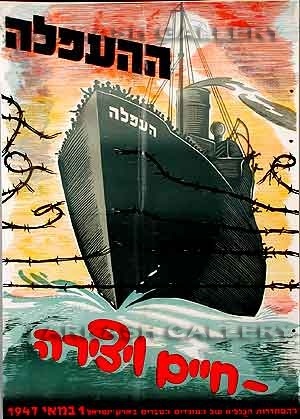This site is dedicated to Shmuel 'Samek' Yanai שמואל 'סמק' ינאי 1925-2011, and the members of Palyam פלי"ם, Machal מח"ל, Bricha בריחה, Kindertransport and the Maapilim מעפילים who, despite the dangers of the voyages, the threat of physical harm and internment by the British, ran the gauntlet to Eretz Yisrael.
Background to "Illegal Immigration" to Palestine

In 1934, the first organized efforts at clandestine immigration by sea were attempted.
Persecution of the Jews in Romania began long before World War II. Under the oppression of the Romanian Iron Guards, the equivalent of the German SS, in 1938, Jews began fleeing from the port of Constanţa to Palestine.
In 1937, the Revisionists started to bring in young people to be farmers and able to defend the settlements against Arab attacks. These were mainly Betar members, the Revisionist youth movement which had training camps in Poland and other European countries. The Revisionists organized boats to carry them, as well as many Jews who were not Betar youths.
The rise of Hitler increased the pressure for aliyah.
In 1938, when the Nazis annexed Austria, Adolf Eichmann was sent to Vienna to facilitate the emigration of the Jews, but no country would give them entry permits.
As soon as the Nazis entered Austria, Jews could no longer leave freely. Betar started having to smuggle thousands of Jews. Hundreds of these refugees were stranded at Balkan ports, waiting for boats without food of clothing. In desperation, they appealed to the Jewish Relief Fund to send them a mere 1,000 British pounds (less than 3 pounds per person).
The appeal was refused, and illegal immigration to save Jews from the Nazis was condemned.
The Revisionists organized an emergency campaign in the United States and South Africa and within a few weeks they had transported all 381 refugees safely to Palestine.
The Jewish Agency would not participate in this traffic, considered illegal by the British, but events forced a change, and Haganah set up an agency called Mossad leAliyah Bet ( Organization for illegal immigration), under Shaul Avigur.
On March 2, 1939, Associated Press dispatched an article describing Constanţa as a huge refugee camp, with thousands of Palestine-bound Jews forming lines in front of travel agencies that sold tickets for fly-by-night shipping companies. This was the beginning of the so-called "coffin ships", as all the boats chartered for this purpose were rickety, unseaworthy, lacking amenities, crammed 5 to 10 times their normal capacities, and their destination was, in most cases, fatal.
This illegal movement, which between 1938 and 1948, transported over 125,000 Jews to Palestine illegally, that is, without entry permits issued by the British government, was called Aliyah Bet, planned, organized, and carried out by several Jewish organizations, and separate from legal immigration, called Aliyah Aleph.
The British issued a White Paper of 1938 restricting Jewish immigration to 75,000 over the following five years. In the same month, two ships were turned away, but others were able to land their passengers, many of whom were captured and interned at camps, until the quota opened.
The British blockaded the shores of Palestine with forty-five of the most modern warships they had built toward the end of World War II. The fleet was large, even by today's standards: cruisers, destroyers, mine sweepers, patrol boats which were armoured and fast. In addition, they dedicated a division of the Royal Air Force, with planes from Palestine. Cyprus, Egypt, and Malta.
The Royal Navy kept constant watch on Haapalah boats trying to reach Palestine. Boats were fired on as they approached the coast, some were turned back; 3 were sunk. In all, twenty-one boats completed the voyage, carrying some 15,000 refugees.
The Aliyah Bet: Bringing the Jews Home
The Fifth Aliyah העלייה החמישית

The The Fifth Aliyah (1929 - 1939) brought in over 250,000 Jews and transformed the character of the Yishuv. Olim came from different countries: Poland, Germany, Austria, Romania, Greece, Yemen and Iraq.
In 1929, the Fifth Aliyah began as a small trickle.
In 1933, when Hitler rose to power in Germany, the trickle became a flood.
Between 1933-36, more than 164,000 Jews entered the country legally, while thousands of refugees came as "illegal" immigrants.
The majority of these olim (80%) settled in the cities and towns, their skills and experience raised business standards and improved urban amenities. Over half the newcomers made their homes in Tel Aviv. In Haifa, the construction of the country first modern port was completed in 1933, and in Jerusalem, the Jewish neighborhoods were largely expanded.
German and Austrians Jews, over a quarter of the total, made an important contribution to the progress of the Yishuv. They constituted the first large-scale influx from Western and Central Europe. A relatively high proportion of the newcomers from Germany and Austria practiced medicine or one of the academic professions; they provided a majority of the musicians who formed the new Philharmonic Orchestra.
20% of the immigrants contributed to the establishment of new settlements, such as Kfar Yanai, Havatzelet HaSharon; moshavim, such as Kfar Vitkin, Avihayil and Kfar Haim; and kibbutzim, such as Maabarot.
From 1936-1939, 53 new settlements, mostly kibbutzim, were established by a method known as Homa uMigdal חומה ומגדל Stockade and Tower.
In 1933 a new type of immigration, called Youth Aliyah, was started, largely financed by Hadassah and organized by Henrietta Szold.
 contact me
contact me